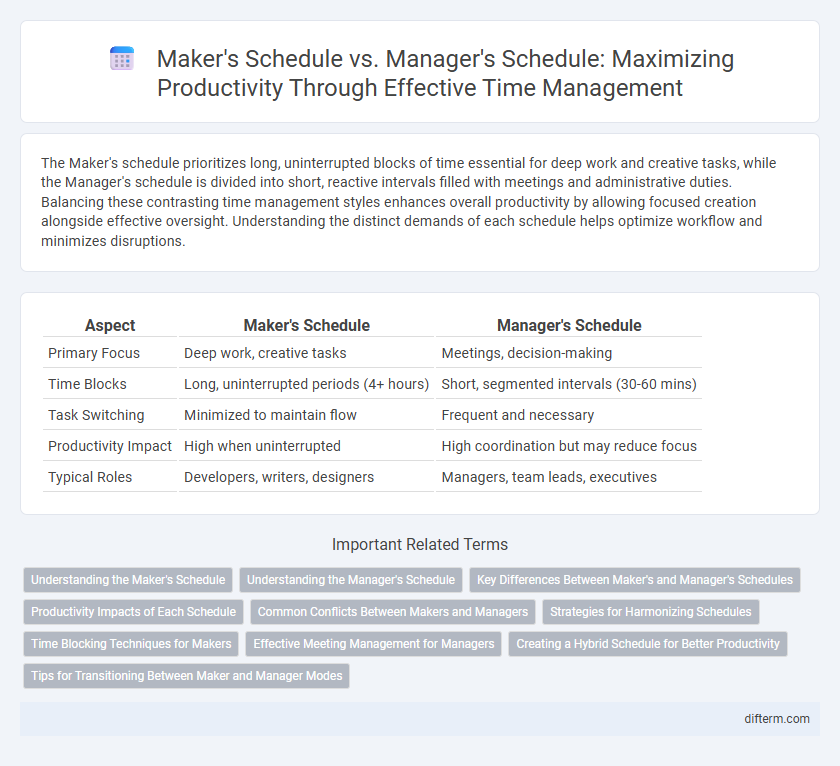The Maker's schedule prioritizes long, uninterrupted blocks of time essential for deep work and creative tasks, while the Manager's schedule is divided into short, reactive intervals filled with meetings and administrative duties. Balancing these contrasting time management styles enhances overall productivity by allowing focused creation alongside effective oversight. Understanding the distinct demands of each schedule helps optimize workflow and minimizes disruptions.
Table of Comparison
| Aspect | Maker's Schedule | Manager's Schedule |
|---|---|---|
| Primary Focus | Deep work, creative tasks | Meetings, decision-making |
| Time Blocks | Long, uninterrupted periods (4+ hours) | Short, segmented intervals (30-60 mins) |
| Task Switching | Minimized to maintain flow | Frequent and necessary |
| Productivity Impact | High when uninterrupted | High coordination but may reduce focus |
| Typical Roles | Developers, writers, designers | Managers, team leads, executives |
Understanding the Maker's Schedule
The Maker's schedule prioritizes long, uninterrupted blocks of time for deep focus and creative work, essential for tasks like writing, coding, or designing. Interruptions in this schedule can severely disrupt productivity, as makers require extended periods to enter a productive flow state. Understanding this schedule helps managers defer meetings or time-sensitive demands to protect the maker's concentrated work intervals.
Understanding the Manager's Schedule
The manager's schedule is divided into numerous short time blocks, typically 30 minutes to an hour, designed to accommodate meetings, decision-making, and task delegation. This segmented structure enables managers to oversee multiple projects and teams efficiently but often disrupts deep, uninterrupted focus. Recognizing this pattern helps optimize productivity by prioritizing quick decision points and aligning tasks that require frequent coordination.
Key Differences Between Maker's and Manager's Schedules
Maker's schedules are structured around long, uninterrupted blocks of time ideal for creative tasks and deep work, while Manager's schedules consist of frequent, short meetings and task-switching to coordinate teams and projects. Makers require extended focus periods to produce high-quality outputs, whereas managers prioritize communication and decision-making to maintain workflow efficiency. Understanding these distinctions helps optimize productivity by aligning work style with task demands and minimizing interruptions for makers.
Productivity Impacts of Each Schedule
Maker's schedule prioritizes long, uninterrupted blocks of time essential for deep creative work, significantly enhancing individual productivity by minimizing context switching. Manager's schedule consists of frequent, segmented meetings designed for decision-making and coordination, which can fragment a day and reduce the ability to focus deeply. Balancing these schedules requires strategic planning to protect makers' focused work periods while accommodating managers' need for communication, ultimately optimizing overall team productivity.
Common Conflicts Between Makers and Managers
Makers typically require long, uninterrupted blocks of time for deep work, whereas managers operate on fragmented schedules filled with frequent meetings and immediate decision-making demands. This fundamental difference often leads to conflicts when managers schedule meetings during makers' peak productivity periods, disrupting flow and reducing overall output. Effective communication and mutual respect for scheduling preferences are essential to minimize friction and optimize team productivity.
Strategies for Harmonizing Schedules
Balancing the Maker's schedule, characterized by long, uninterrupted blocks for deep focus, with the Manager's schedule, segmented into brief, task-oriented meetings, demands clear boundary-setting and prioritized time blocking. Implementing strategic calendar management, such as designating specific hours for creative work and others for administrative tasks, enhances productivity for both roles. Leveraging asynchronous communication tools reduces interruptions, allowing Makers to maintain flow while keeping Managers informed and responsive.
Time Blocking Techniques for Makers
Time blocking techniques for makers involve scheduling large, uninterrupted periods to focus on deep work and creative problem-solving, essential for productivity in software development and content creation. By allocating specific blocks exclusively for tasks like coding, designing, or writing, makers minimize context switching and maximize cognitive flow. This disciplined approach contrasts with managerial schedules often segmented by meetings, allowing makers to harness peak mental energy for high-impact outcomes.
Effective Meeting Management for Managers
Managers operate on a segmented schedule filled with back-to-back meetings, requiring precise time allocation to maintain productivity. Effective meeting management involves setting clear agendas, limiting attendee numbers, and enforcing strict time limits to prevent schedule fragmentation. This structured approach helps managers preserve critical blocks of uninterrupted time necessary for strategic thinking and decision-making.
Creating a Hybrid Schedule for Better Productivity
Balancing a hybrid schedule integrates the uninterrupted, deep work blocks favored in the Maker's schedule with the structured, segmented time slots typical of the Manager's schedule, fostering enhanced productivity. Prioritizing flexible periods for creative tasks alongside fixed meeting times reduces context switching, enabling sustained focus and efficient collaboration. Implementing dedicated intervals for both strategic planning and operational management supports seamless workflow synergy and maximizes output quality.
Tips for Transitioning Between Maker and Manager Modes
Switching effectively between Maker and Manager modes requires clear time-blocking strategies that allocate uninterrupted hours for deep work and segmented periods for meetings and administrative tasks. Prioritizing tasks by urgency and context allows seamless transitions, ensuring that creative flow during Maker mode remains undisturbed while managerial responsibilities receive focused attention. Utilizing tools like calendar buffers and task batching enhances productivity by minimizing cognitive switching costs between divergent work types.
Maker's schedule vs Manager's schedule Infographic

 difterm.com
difterm.com